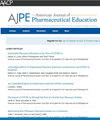四选项选择题与三选项选择题的项目辨析、难度和反应时间
IF 3.8
4区 教育学
Q1 EDUCATION, SCIENTIFIC DISCIPLINES
引用次数: 0
摘要
目的研究三选项选择题与四选项选择题在难度、辨析和反应时间上的差异。方法将2017 - 2020年生物统计学期末考试的20个题目作为4选项,2021 - 2024年作为3选项。三选项项目是通过移除最少选择的干扰因素来创建的。每个题目的平均难度、辨别度和反应时间都是从Examsoft提供的综合考试成绩数据中收集的。配对t检验用于比较四选项和三选项之间的考试成绩指标。结果四选项题难易度(89.75±8.45%)与三选项题难易度(86.45±15.98%)无显著差异(p = 0.08)。然而,选项辨析从四选项的0.23±0.11提高到三选项的0.29±0.09 (p =.03),而选择题的反应时间从四选项的42.50±14.70 s降低到三选项的38.10±17.78 s (p =.02)。结论在不影响试题难度的情况下,三选项题比四选项题在药学教育中具有优势,减少了试题时间,增强了试题辨析能力。药学教育工作者和学者应进一步探索在不包含心理测量质量的前提下优化评估效率和效果的策略。本文章由计算机程序翻译,如有差异,请以英文原文为准。
Item Discrimination, Difficulty, and Response Time for 4-Option Multiple Choice Questions Versus 3-Option Multiple Choice Questions
Objective
The purpose of this study was to examine differences in item difficulty, discrimination, and response time for multiple-choice exam items with 3 answer options compared with items with 4 answer options.
Methods
Twenty items were administered on the Biostatistics final exam as a 4-option item from 2017 to 2020 and as a 3-option item from 2021 to 2024. The 3-option items were created by removing the least chosen distractors. Mean item difficulty, discrimination, and response time for each item were collected from aggregate exam performance data provided by Examsoft. Paired t tests were used to compare exam performance metrics between 4-option items and 3-option items.
Results
Item difficulty did not differ between 4-option items (89.75 ± 8.45%) and 3-option items (86.45 ± 15.98%, p =.08). However, item discrimination improved from 0.23 ± 0.11 for 4-option items to 0.29 ± 0.09 for 3-option items (p =.03), whereas response time per multiple choice question (MCQ) decreased from 42.50 ± 14.70 s for 4-option items to 38.10 ± 17.78 s for 3-option items (p =.02).
Conclusion
Three-option MCQs may offer advantages over 4-option MCQs in pharmacy education by reducing time spent per exam item and enhancing item discrimination without impacting item difficulty. Educators and scholars in pharmacy should further explore strategies for optimizing assessment efficiency and effectiveness without comprising psychometric quality.
求助全文
通过发布文献求助,成功后即可免费获取论文全文。
去求助
来源期刊
CiteScore
4.30
自引率
15.20%
发文量
114
期刊介绍:
The Journal accepts unsolicited manuscripts that have not been published and are not under consideration for publication elsewhere. The Journal only considers material related to pharmaceutical education for publication. Authors must prepare manuscripts to conform to the Journal style (Author Instructions). All manuscripts are subject to peer review and approval by the editor prior to acceptance for publication. Reviewers are assigned by the editor with the advice of the editorial board as needed. Manuscripts are submitted and processed online (Submit a Manuscript) using Editorial Manager, an online manuscript tracking system that facilitates communication between the editorial office, editor, associate editors, reviewers, and authors.
After a manuscript is accepted, it is scheduled for publication in an upcoming issue of the Journal. All manuscripts are formatted and copyedited, and returned to the author for review and approval of the changes. Approximately 2 weeks prior to publication, the author receives an electronic proof of the article for final review and approval. Authors are not assessed page charges for publication.

 求助内容:
求助内容: 应助结果提醒方式:
应助结果提醒方式:


